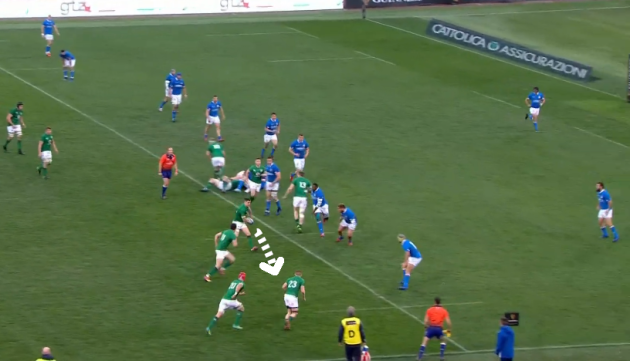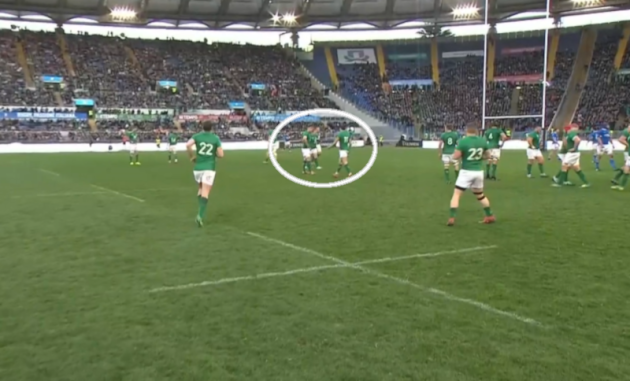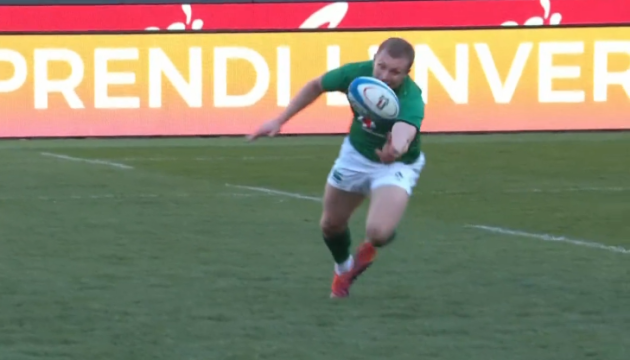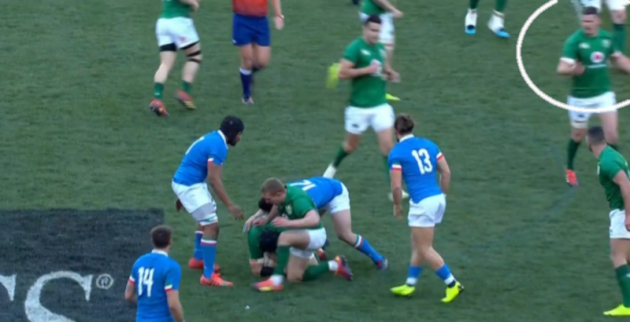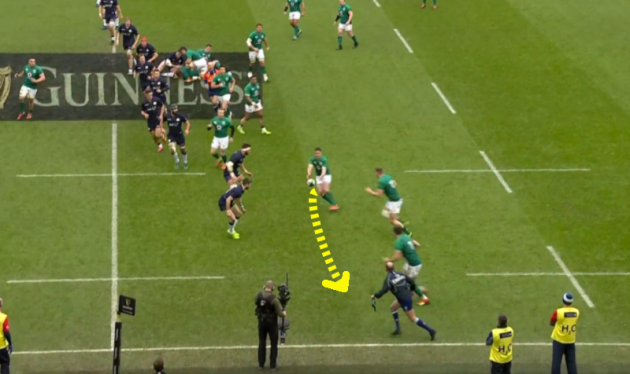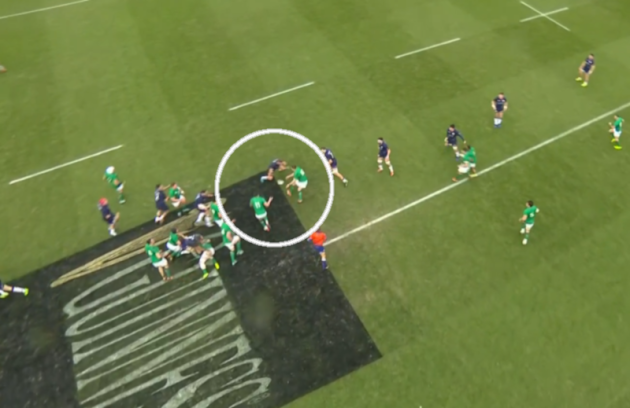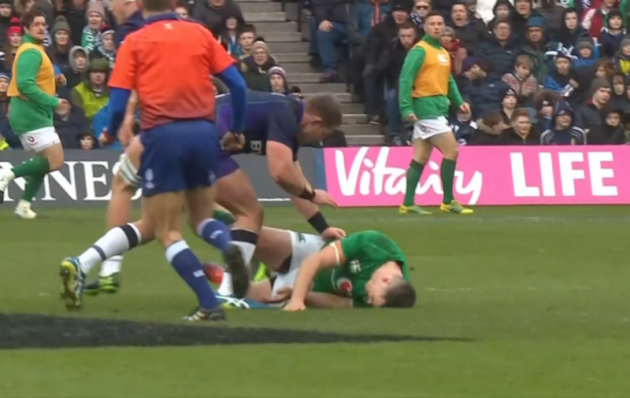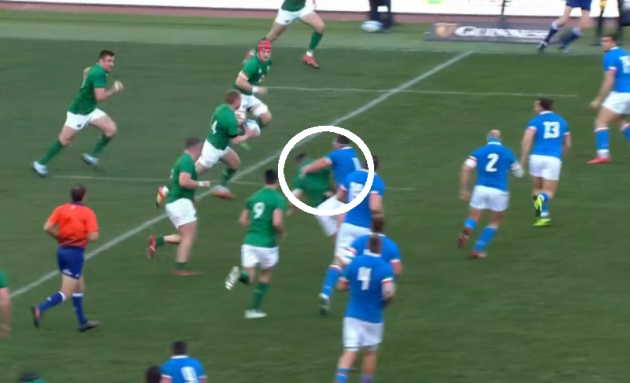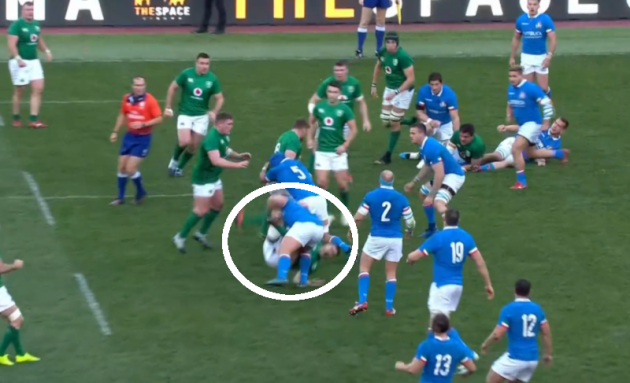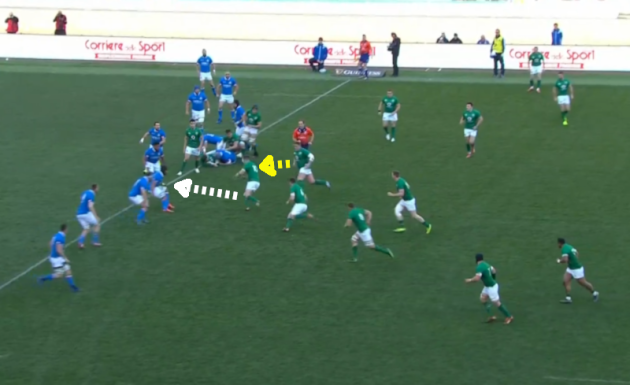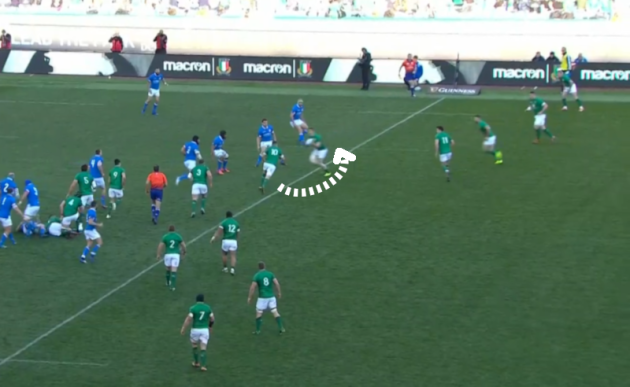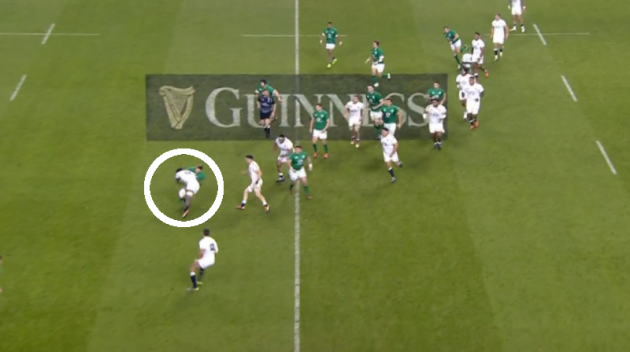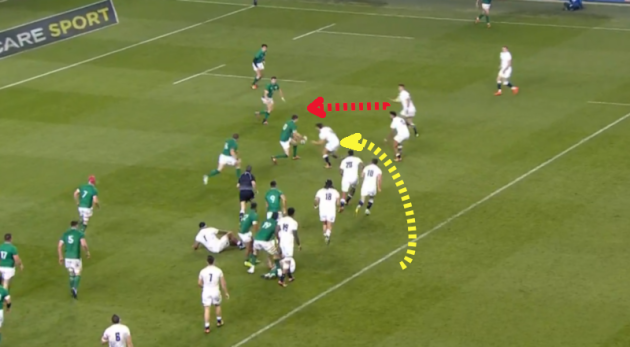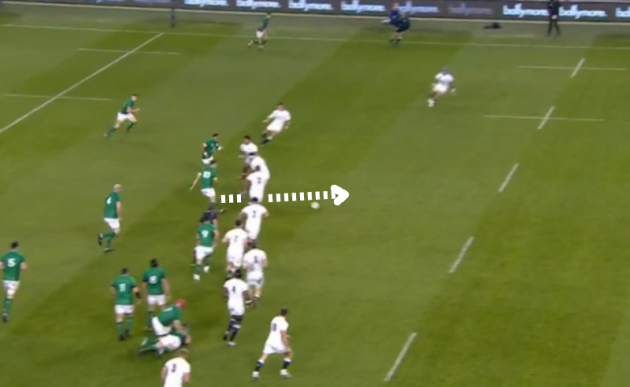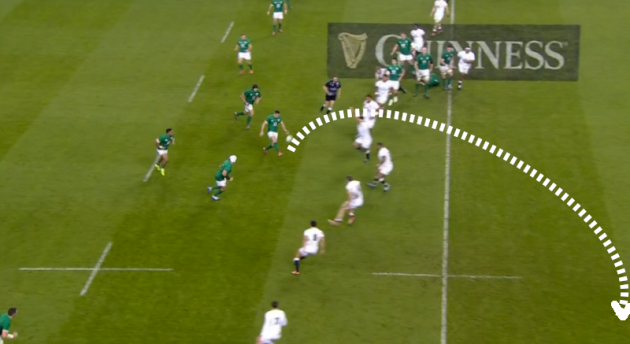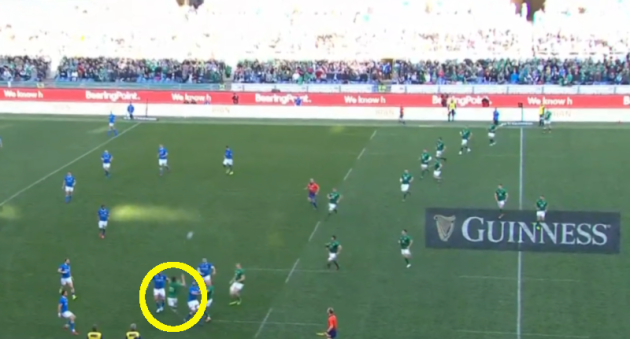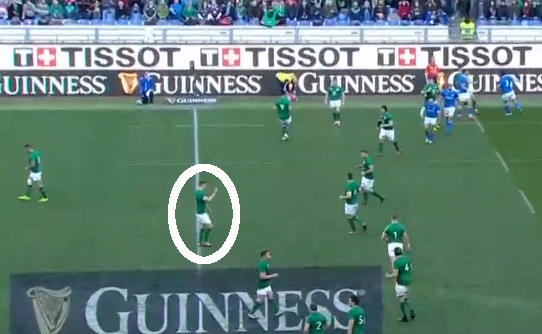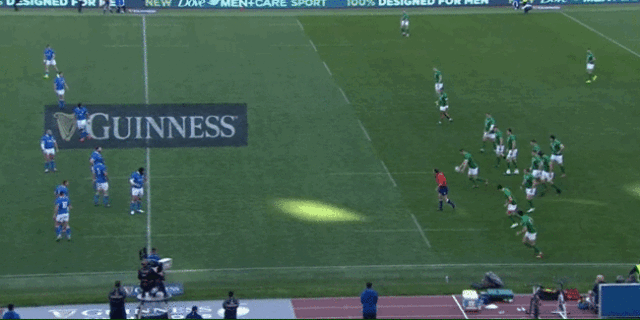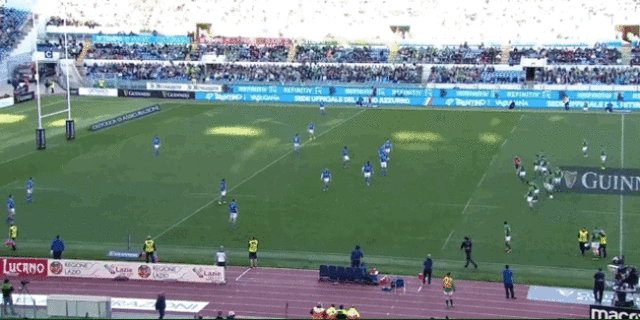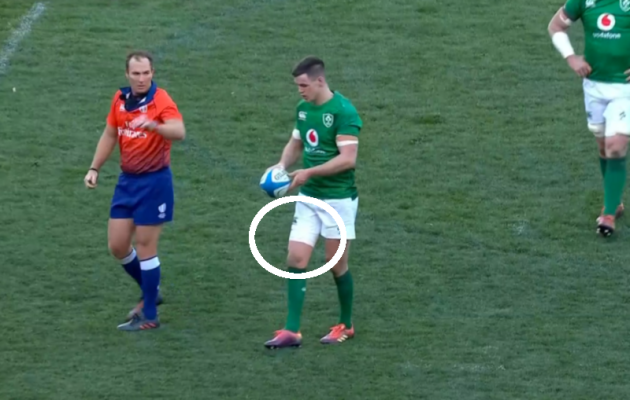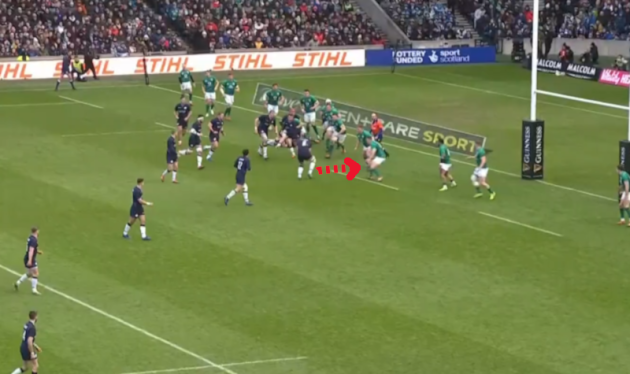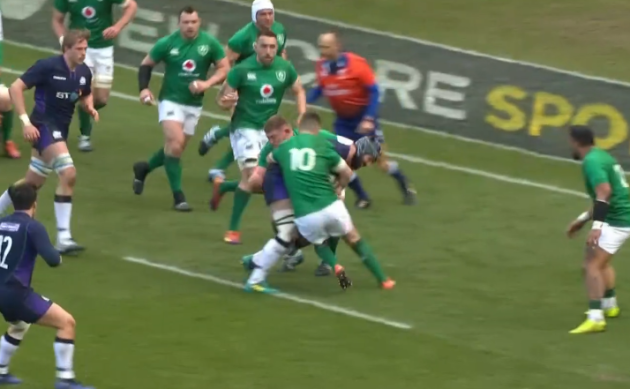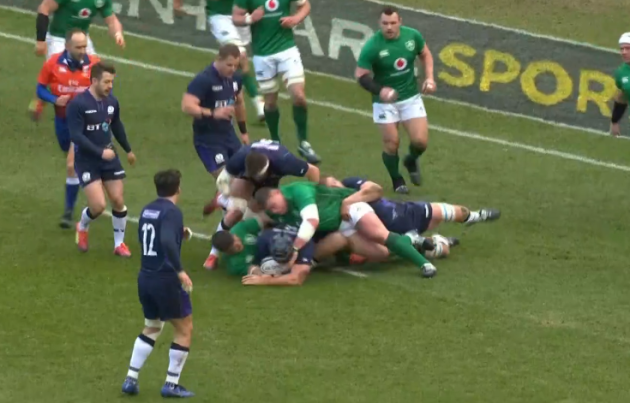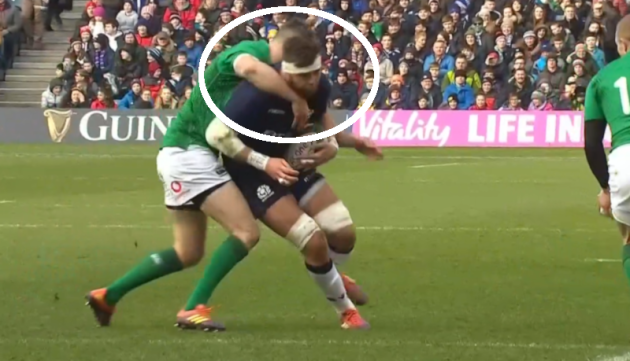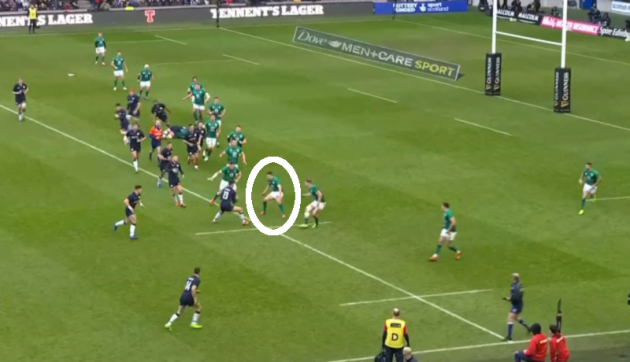“FUCKING CATCH THE fucking ball!”
Johnny Sexton’s frustration as he left the pitch at Stadio Olimpico on Sunday was understandable, even if some critics feel he should be better at controlling his emotions and impulses during games.
Just before Sexton was replaced by debutant Jack Carty, Ireland had made their latest handling error, with Jacob Stockdale knocking-on the out-half’s pass, Sexton clearly displeased at the 22-year-old wing not gathering the ball.
It was one of a total of nine dropped balls from Ireland in a performance where Joe Schmidt’s team turned the ball over at a concerning rate – stymying any chance of getting into the attacking flow they had targeted in this game.
Sexton’s frustration was naturally based around the collective underperformance from Ireland, but quite probably also around his own display – which was not of the standard he demands from himself.
Like his halfback partner, Conor Murray, Sexton has not yet hit the form he is capable of in this Six Nations, although some of the debate around him has perhaps overlooked some of the positive contributions he has made.
A lack of game time in the immediate run-up to the Six Nations may have affected him, with Sexton missing Leinster’s Heineken Cup fixtures in January due to a knee tendon injury, while his early removal after a failed HIA against Scotland prevented him from getting fluidity into his game.
Sexton and Murray’s struggles for their best form are reflective of Ireland’s issues as a whole – a lack of cohesion and uncharacteristic execution errors, mixed in with passages of quality play.
Schmidt and his coaches are unlikely to be panicking and will stress to their halfbacks and the rest of the squad to relax and trust their proven world-class ability ahead of the closing two rounds of the Six Nations as Ireland aim to finish strongly.
Ball down
The ball has gone to ground after five of Sexton’s 86 passes in this championship so far.
That’s five too many from the Ireland out-half’s point of view and has fed into his frustration.
These Irish errors are symbolic of how Schmidt’s side have struggled to deliver cohesive form and, almost fittingly, Sexton’s final pass against Italy ended up on the ground.
It’s a simple pass over a couple of metres from Sexton to Stockdale, with the out-half putting the ball in front of his left wing to run onto…
… but at the last split second, Stockdale pulls his hand away [white above], appearing to believe the pass may instead be intended for Josh van der Flier outside him.
Sexton throws his arms out in dismay [yellow below], while Stockdale [white] does something similar.
Sexton seemingly feels Stockdale should have caught the ball, while Stockdale seems to be frustrated that the pass was not more clearly meant for him.
On reflection, Stockdale – who had a good game in Rome – probably should have caught the ball here but Sexton’s pass could also have been more sympathetic.
20 seconds later, as Jack Carty runs on to replace Sexton, the out-half is discussing the incident with Stockdale.
Whatever about identifying the error here, Ireland’s reaction to mistakes has been poor at times in this championship – as with Murray when he was pick-pocketed by Tito Tebaldi.
Schmidt is likely to stress to his players that their response to errors – which are part of the sport – must be more positive moving forward.
Sexton’s pass to Keith Earls earlier in this game also ended up on the ground and resulted in Ireland giving away a penalty as Sean O’Brien picked the ball up.
Again, it’s a basic error from Ireland as they launch off a lineout and Sexton’s tunnel pass between Andrew Conway and Chris Farrell is out in front of Earls, too far in front.
Earls can’t gather the ball in and, again, Sexton’s react is one of frustration.
Similarly to the Stockdale situation, Sexton’s pass could have made life easier for Earls here, although it’s likely that the planned set-play called for the Munster man to be flatter to receive the ball.
This incident comes just after the early head injury to Bundee Aki, which forced him off after 11 minutes and meant a reshuffle in Ireland’s backline.
The knock-on effect of that was a further lack of cohesion, which Ireland certainly didn’t need in this game against Italy, explified in this incident.
Early in the Scotland game, one of Sexton’s passes ended up on the ground as he passed back inside to Stockdale only for the left wing to knock-on, having arrived a little too early.
And there were two balls to ground from Sexton against England, when he was frustrated at Rory Best and then Sean Cronin for not running onto the passes he had released.
All in all, these errors serve to highlight the issues Ireland are having in this Six Nations. They have not combined as consistently as is usually the case, with the issue naturally accentuated around Sexton, their primary playmaker.
Ball to hand
However, it is worth noting that Ireland have fired off Sexton’s playmaking at other times, looking far more like the team that had such a happy 2018.
Sexton’s passing in this Six Nations has predominantly been excellent and his superb pass early on against Scotland played a key role in Murray’s opening try.
An intelligent decoy line close to the ruck from Jack Conan is important in narrowing up the Scotland defence as Murray feeds Earls at first receiver.
Earls delivers the ball on to Sexton [white above] at second receiver and now the three-on-two beckons on the edge.
It has been noticeable that Sexton has lined up at second receiver on a number of occasions in this championship, with Earls and Aki being more prominent than usual as first receivers. Here, we see the value of Sexton being positioned slightly wider.
The out-half takes a few vital straightening steps on his own running line just before he releases an accurate skip pass across Farrell to Stockdale on the left touchline.
Stockdale accelerates into the space, drawing up Finn Russell from the backfield, then chips ahead accurately, with Farrell applying suffocating pressure on the chase and forcing an error from the retreating Tommy Seymour to allow Murray to finish.
It’s a superb contribution from Sexton and he had another before his 23 minutes on the pitch were up, linking with Stockdale again for Ireland’s second try.
We analysed this power play score from Ireland in detail at the time, but it’s worth underlining again how Sexton nails his role in the play and shows his selflessness in drawing Allan Dell right into the tackle before releasing the ball to Stockdale.
Sexton, as he does better than most out-halves in the game, takes the ball right up to the tackle point before passing.
The cost is being hammered in the tackle by Dell and Sexton is heavily put to ground, contributing to his early removal from the game.
Punishment
The punishment Sexton takes in contact has been a theme again during this Six Nations and seems likely to linger on as opposition players take every opportunity to leave a mark on him, some of it legally.
Italy’s Andrea Lovotti was penalised for a late hit on Sexton in Rome, having fired his right shoulder in after the Ireland out-half had passed to Earls.
There was arguably a worse offence from Lovotti only minutes earlier, as he engaged in a tackle on Sexton after he had passed to Jordi Murphy, dumping the out-half into the ground.
Lovotti was not penalised on this occasion, however, and seemed to take some encouragement from the fact.
While these two incidents are illegal, Sexton has been fairly hammered in the tackle on other occasions, paying the price for his penchant for straightening up before passing and working hard to fix defenders.
Sexton will continue to accept the occupational hazards for the good of the team.
Directing
Perhaps the most positive passage from Ireland in attack against Italy was the 19-phase set that produced Quinn Roux’s try.
Having struggled for variety in their phase play in the 22 against Scotland, this was a major improvement against Italy, with Sexton having seven touches of the ball and one carry, to go along with how Ireland used ball-carriers off Murray.
Above, Sexton straightens at the defensive line [white] before passing back inside to Tadhg Furlong [yellow] for a carry beyond the gainline.
Below, Sexton runs his characteristic loop line [white] around the straight-running Farrell and carries for another short gain.
With Ireland’s ball-carriers bringing energy off scrum-half Murray’s passing too, as well as Furlong throwing an offload to Roux and Farrell contributing a vital carry just before the score, the variety of Ireland’s pressurising phase play cracks Italy.
With Sexton directing play intelligently outside Murray, it’s a passage that will have encouraged Schmidt and the head coach is likely to highlight it as something Ireland can strive for more of.
At other stages of his championship, Sexton’s decision-making and direction have been lacking.
The example above comes against England, as Sexton opts to attack wide off poor possession just after his pass to Cronin has gone to ground.
Sexton receives a pullback pass from O’Brien [yellow] and then directs his own pass [white] out the back of Dave Kilcoyne to Garry Ringrose.
With England’s defensive line well set, that invites pressure and Courtney Lawes – who levelled Sexton only minutes before – shoots up to hammer Ringrose.
England win a penalty at the breakdown and kick three points to move 25-13 in front, but Ireland continue to force play as they desperately search for a way back into the game.
With Ben Youngs making an excellent read [yellow above] to apply pressure up out of the defensive line, Sexton fires a blind pass to his left and Henry Slade [red] picks it off to score a bonus-point try for England, causing further damage to Ireland’s title hopes.
Kicking
Sexton has kicked the ball in play only 11 times this championship, which would likely have been higher had he not been replaced early against Scotland.
One element of Ireland’s struggle against England was that they didn’t get their kicking game going to a consistent degree of success as the English defence dominated in the tackle.
There were accusations that Ireland didn’t attempt to alter their approach in the face of England’s linespeed but that is an inaccurate argument.
Ireland’s first-half try through Cian Healy stemmed from a good Sexton chip kick in midfield, into the space behind the linespeed.
Sexton followed up to apply pressure on the retreating Billy Vunipola, forcing the England number eight to knock-on…
… before Jamie George gathered the ball in an offside position. The resulting penalty allowed Ireland into the right corner, where they scored through Healy.
Sexton also kicked the ball five times in the opening six minutes of the second half, clearly following a tactical refocusing during the break.
Those kicks included an excellent grubber behind the advancing English defence…
… which Aki would have had a strong chance of retrieving, only to be blocked out [red below] by Manu Tuilagi and Mako Vunipola.
That gives Jack Nowell time to scamper infield and slide down onto the ball, although he knocks-on in the process.
Referee Jerome Garces sticks out his hand for an advantage, which Ireland presume is a penalty advantage, and Sexton unsuccessully attempts a cross-field kick in the ensuing passage.
However, the advantage has expired, with Garces having seemingly played a knock-on advantage, when Ireland really should have had a penalty and access into the England half.
Just before this grubber, Sexton had dinked a diagonal kick over the edge of the England defence…
… but the well-executed kick bounces into touch as only Peter O’Mahony is holding width for Ireland.
The flanker doesn’t have the pace to chase the kick and Sexton is frustrated once again, turning back to remonstrate with right wing Jordan Larmour, who is out on the other side of the pitch after the initial set-piece strike from Ireland.
Sexton attempted to launch a contestable kick up over England fullback Elliot Daly with his first kick of the second half, only to be blocked down, while his other effort at a contestable in this championship came against Scotland and was too long, allowing Stuart Hogg time to mark the ball and kick clear.
While Sexton has had a handful of good kicks in play in this championship, this element of his game has yet to truly fire. Ireland have also missed the grubber-kicking option Ringrose provides at outside centre.
Restarts and line kicks
Sexton’s mixed performance against Italy was well summed up in his restarts and line kicks.
There were a couple of superb restarts, with Stockdale scoring a try as Italy botched one and the left wing retrieving [yellow below] another excellent kick from Sexton after the Italians kicked their second penalty.
This combination between Sexton and Stockdale on short restarts was a continuation of their work against New Zealand in November, when they applied great pressure.
Soon before the moment above, howver, Sexton was too heavy with his drop-kick on a 22-metre restart, forcing Stockdale to leap off the toucline in a bid to keep the ball in play.
And the restart of the second half from Sexton failed to go the required 10 metres as he once again looked to link with Stockdale.
It’s a bad start to the second half for Ireland, handing Italy the initiative and it’s also very uncharacteristic from Sexton, who immediately puts his hand up to apologise for his error.
These are two poor restarts from Sexton but the hope is that Ireland are not discouraged from their short restarting tactics, using Stockdale’s height and leap to their advantage.
It has been a positive development in their game in recent times and Schmidt must continue to push his players to back their skills in this area.
Sexton is generally a superb line kicker with penalties, often eking out additional metres that more conservative players don’t look for.
In this game against Italy, there were several examples of strong linekicking from Sexton again, including the brilliant effort below.
Click here if you cannot view the clip above
However, there was more inconsistency from Sexton in this area, with a handful of poor connections on linekicks later in the game, including the scuffed effort below.
Click here if you cannot view the clip above
Sexton was evidently annoyed with himself in this instance, relatively rare for a player who spends long hours working on his kicking skills.
It was also noticeable that Sexton had strapping on his kicking leg in this game, something that was not present in the two previous fixtures.
Sexton is not a player who likes to make excuses and it’s unclear what the physical issue was but the out-half was clearly nursing something coming into this game.
Regardless, his poor striking on a couple of linekicks and two bad restarts will not be acceptable to him, although it would be worth him [and Ireland] also looking at the many good examples in these areas as he and his team look to regain confidence.
Defence
Sexton is one of the best defensive out-halves in the game and he has largely been effective in his contributions when Ireland haven’t had the ball.
The 33-year-old has a consistently high focus into the tackle, targeting the ball for strips and choke tackles. It’s something he has always done and it’s highly unlikely to change now.
Josh Strauss [red above] carries for Scotland early on at Murrayfield in the example above, with Sexton going in high to target the ball and Furlong powering into the tackle too.
With Sexton being a threat to possession with a strip of the ball and Furlong driving into him, Strauss can’t bring leg drive and the Irish pair put him to ground for a negative carry.
As we know, discipline is a huge focus for Schmidt’s Ireland and Sexton will be disappointed to have conceded two penalties in defence so far in this championship.
The first was a failure to roll away from a tackle against England, while the second was a high tackle on Ryan Wilson in the Scotland fixture.
This is one of the dangers with Sexton’s focus on upper-body tackling, although he is generally very well disciplined.
The Leinster man is a superb reader of the game, as evidenced by two interceptions so far in the championship, one coming against Scotland and the other against Italy last weekend.
Sexton has completed 21 tackles so far in this Six Nations and his only damaging tackle miss came against Scotland soon before he was failed his HIA, perhaps explaining the uncharacteristic nature of how he was beaten.
Sexton is usually proactive in keeping his feet alive into the tackle but, as we can see above, he plants his feet early and sits onto his heels here when confronted with Blair Kinghorn.
Having initially run an ‘unders’ line at Sexton’s inside shoulder, Kinghorn turns on his excellent footwork to burst off his left and get well outside the range of Sexton’s shoulder, leaving the Ireland 10 grasping out with his arms in a tackle attempt.
Kinghorn makes the bust and Ireland barely survive as O’Mahony cynically kills the ball at the next breakdown.
However, it’s a rare error from the out-half in defence and with Sexton always more than willing to throw himself into contact, his communication skills being so strong and his intelligence allowing him to make good reads, he remains a key figure when Ireland don’t have the ball.
Striving for better
Sexton hasn’t got firing off the place-kicking tee in this championship yet, handing over the duties to Murray in the Scotland game and also versus the Italians.
Again, this would suggest that Sexton is dealing with a physical issue – as indicated by the strapping – and he possibly should have handed over the tee earlier against Scotland, when he missed the straightforward shot at goal after Murray’s try, having just received lengthy treatment from Ireland’s medical team.
While Sexton will be keen to get back onto the pitch against France in two weekends’ time and exorcise any demons left over from Rome, there would also seem value in Schmidt and his coaching staff reminding the out-half of the quality he has contributed in this championship and so often before for Ireland.
Sexton has clearly been short of his best form but the Ireland playmaker and his team are not too far from delivering the kind of performance they crave.
Subscribe to our new podcast, The42 Rugby Weekly, here:

